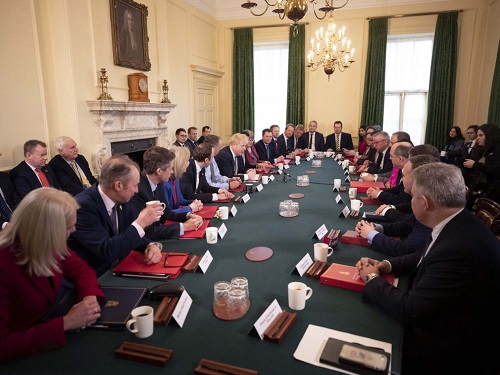Setareh Keyhani wrote in a note to the International Relations Think Tank: In the United Kingdom, the government consists of the chief or head of the executive – the Prime Minister – plus his or her chosen Cabinet and junior ministers. Other political systems organise their executives in similar ways
the writer: Setareh Keyhani – British Studies MA Student – Faculty of world Studies ( FWS) – University of Tehran

IRTT: The Cabinet dominates the executive branch of government in Britain. Britain is therefore traditionally said to have cabinet government made up of a relatively small group of MPs drawn from the legislature and headed by the Prime Minister. The Cabinet is traditionally said to operate as a decision-making body, to provide an opportunity for the general management over the formulation of policy, and to give some clear cohesion to the programme on which the government has been elected. In doing this, the structure of the Cabinet should allow all departmental perspectives and competing claims to be filtered through the specific issue being debated
The Prime Minister
The Prime Minister chairs the modern Cabinet. It will be the Prime Minister who will select those Members of Parliament who will sit in the Cabinet and who will eventually reshuffle them around the cabinet table or sack them. Most cabinet members have the title ‘Secretary of State’ and will be given responsibility for managing a Department of State, or ‘Ministry’
Given the scale of what we have already described, it should come as no surprise to discover that the modern Cabinet requires a substantial bureaucracy to help with the growing amount of administration. Since 1916, the business of the Cabinet – its agendas, discussions, decisions and minutes – has been the responsibility of a cabinet office headed by a cabinet secretary. The Cabinet Office is based in 10 Downing Street from where it organises every aspect of the work of Cabinet and its numerous subcommittees and groups
The position of the Prime Minister is similar to that of the Cabinet in that it has no clear constitutional role. Nevertheless, the office of Prime Minister is now undoubtedly at the very heart of the executive and, as such, holds substantial political power. Because of the vague nature of the Constitution on the position of the Prime Minister, and because of the particular way that the position has evolved, there are substantial and far-reaching powers now associated with the office that are not always immediately obvious simply by observing the ‘official’ powers
The main powers that the Prime Minister has at his or her disposal are known as prerogative powers and are derived from those functions that, before 1688, were performed by the monarchy. This constitutional convention (there are no statutes or legal rulings that confirm this state of affairs) allows the Prime Minister to carry out functions in the name of the monarchy even though the crown plays no active part in them
The United Kingdom has parliamentary government. In a parliamentary system the government is held to be collectively accountable to the legislature for the decisions that it makes and will remain in office only for the time that it can retain the confidence of that body
.In the coming weeks, we will talk more about the political system of the United Kingdom and the role of the Prime Minister


